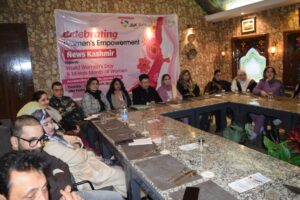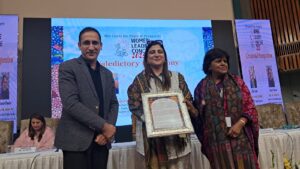Financial Literacy for Women in Kashmir: The Power to Rise
By Tyima Bilal
When the first light of dawn touches the snow-capped peaks of Kashmir, women are already awake. They are already in motion.They carry baskets into saffron fields, their breaths visible in the crisp morning air. They weave Pashmina under the soft glow of a kangri. They tend to orchards, bake bread, sew garments, and run classrooms.They create beauty, value, and tradition, but too often, they do not control the money their work brings. Financial decisions, in many homes, are still left to men. And this silent exclusion holds back not just the women, but the entire community. They are the heartbeat of the valley, quiet, tireless, and strong. Yet too many times, their work ends with little more than the satisfaction of labour. The money they earn often slips from their hands before it can change their lives.
This is why financial literacy, the ability to understand, manage, and grow money,is not just helpful. In Kashmir, it is urgent. It is a tool of survival, a shield against uncertainty, and a ladder toward independence.
Breaking the Cycle of Dependency
Imagine a woman who spends months embroidering a shawl that will sell for thousands. When the pay ment comes, it is taken from her hands,sometimes with love, sometimes with authority, and she is left with little more than the pride of her craft. She is the maker of value, yet not the owner of it.A woman without financial knowledge may be left without savings, without a safety net, and without the ability to navigate the banking system. But when she knows how to manage money, she gains the courage to make choices for herself and her family.A financially literate woman in Kashmir is not just someone who can calculate profits from selling her handicrafts, she is someone who can plan for her children’s education, invest in her own business, and face life’s uncertainties with confidence.
ment comes, it is taken from her hands,sometimes with love, sometimes with authority, and she is left with little more than the pride of her craft. She is the maker of value, yet not the owner of it.A woman without financial knowledge may be left without savings, without a safety net, and without the ability to navigate the banking system. But when she knows how to manage money, she gains the courage to make choices for herself and her family.A financially literate woman in Kashmir is not just someone who can calculate profits from selling her handicrafts, she is someone who can plan for her children’s education, invest in her own business, and face life’s uncertainties with confidence.
 ment comes, it is taken from her hands,sometimes with love, sometimes with authority, and she is left with little more than the pride of her craft. She is the maker of value, yet not the owner of it.A woman without financial knowledge may be left without savings, without a safety net, and without the ability to navigate the banking system. But when she knows how to manage money, she gains the courage to make choices for herself and her family.A financially literate woman in Kashmir is not just someone who can calculate profits from selling her handicrafts, she is someone who can plan for her children’s education, invest in her own business, and face life’s uncertainties with confidence.
ment comes, it is taken from her hands,sometimes with love, sometimes with authority, and she is left with little more than the pride of her craft. She is the maker of value, yet not the owner of it.A woman without financial knowledge may be left without savings, without a safety net, and without the ability to navigate the banking system. But when she knows how to manage money, she gains the courage to make choices for herself and her family.A financially literate woman in Kashmir is not just someone who can calculate profits from selling her handicrafts, she is someone who can plan for her children’s education, invest in her own business, and face life’s uncertainties with confidence. When Knowledge Becomes Freedom
Financial literacy is not simply about counting money,it is about claiming the right to decide. It is the power to say, “This is my earning, and I will use it to secure my child’s education, to invest in my dream, or to save for a day of uncertainty.” For a woman in Kashmir, understanding how to open a bank account, apply for a loan, or invest in a small business can mean the difference between dependence and dignity. It can mean the ability to leave an unsafe marriage. It can mean feeding her family when the orchards fail. It can mean standing tall when the world expects her to bow.Empowering a woman financially does not end with her. A financially literate mother teaches her children to be responsible with money. A financially independent sister inspires her siblings to dream bigger. A woman entrepreneur creates jobs, supports local economies, and breaks stereotypes.It’s not an exaggeration to say: when you educate a woman about finance, you uplift an entire community.
The barriers faced
When a woman is not financially stable, her life becomes a constant struggle between dignity and survival. Through her husband, she may face control, dependency, and sometimes even neglect, with no say in how money is spent. Through society, she bears judgment for her helplessness, as if poverty is her fault. And when a crisis strikes, when her child needs urgent medical care or her family needs shelter, the lack of even a small sum feels like a mountain she cannot climb. In those moments, financial independence is not a luxury, it is her lifeline.A woman without financial stability walks through life with invisible chains. Her dreams are paused by dependence on her husband’s will, her choices silenced by the weight of tradition. Society questions her worth, yet offers no hand when she stumbles. The simplest needs,a child’s hospital bill, repairs for her home, even a warm meal, become battles she cannot fight alone. These barriers are not just about money; they are about dignity, voice, and the power to stand without fear.
Government’s Role: Turning Promises into Pathways:
For Kashmiri women to break free from the cycle of financial dependency, government action must go beyond words on paper. It must be felt in their villages, in their markets, and in their bank accounts.
1. Financial Literacy Programs in Every District The government can set up women-focused financial literacy centers in rural and urban areas, where women learn about budgeting, savings, investments, and government schemes in simple, local languages.
2. Access to Credit & Microfinance: Many women with skills and dreams lack the capital to start. Low-interest loans, microfinance opportunities, and easy access to bank accounts can transform those dreams into businesses.
3. Skill Development & Employment Opportunities :Linking skill training programs directly with job placements or small-business grants ensures that learning translates into earning.
4. Health & Emergency Funds :Government-led women’s emergency funds can provide immediate financial aid for hospital bills, childbirth, or other urgent needs, a safety net that saves lives.
5. Digital Access & Banking Infrastructure:Expanding internet connectivity and digital banking services into remote villages ensures that women can manage finances without depending on others for travel or information.
The Call to Every Woman in Kashmir
Dear sisters, your dreams deserve more than waiting for someone else’s permission to come true. Financial independence is not just about money, it is about your voice, your choices, and your dignity. The moment you earn and manage your own income, you unlock the power to decide for yourself, to stand tall even when life shakes you, and to protect those you love without fear. No matter how small you start , a skill, a savings jar, a home-based venture, it is the first step towards a life where you are the author of your story. The world respects a woman who can stand on her own feet , be that woman.
To the women who rise before sunrise,
To the mothers who give without keeping,
To the dreamers waiting for the right time, The right time is now.
Financial literacy is not just about money,it is about dignity, safety, and power. It is the difference between hoping for security and building it yourself.
The valley has always been full of women who endure. Now, it must be full of women who decide. Because when a Kashmiri woman learns to manage her money, she does not just transform her life,she transforms the future of her family, her community, and her land.And in a place as breathtaking as Kashmir, women deserve to rise as high as its mountains and shine as brightly as its morning sun.
“When women earn, they don’t just make a living, they make a difference.”
Penned by Tyima Bilal, for every woman who dreams of walking her own path.


 , and summers have intensified and become drier. Glaciers are melting at a rate that is nothing short of alarming, with some estimates suggesting as much as 0.5 meters annually. Spring comes earlier than usual, and rainfall is becoming spasmodic, leading to flash floods one day and weeks of unending dryness the next. The apple belt of the region is creeping up in altitude, while traditional crops such as saffron are being plagued by unpredictable weather.
, and summers have intensified and become drier. Glaciers are melting at a rate that is nothing short of alarming, with some estimates suggesting as much as 0.5 meters annually. Spring comes earlier than usual, and rainfall is becoming spasmodic, leading to flash floods one day and weeks of unending dryness the next. The apple belt of the region is creeping up in altitude, while traditional crops such as saffron are being plagued by unpredictable weather.


 ithout Direction: The Employment Drought in Jammu and Kashmir
ithout Direction: The Employment Drought in Jammu and Kashmir